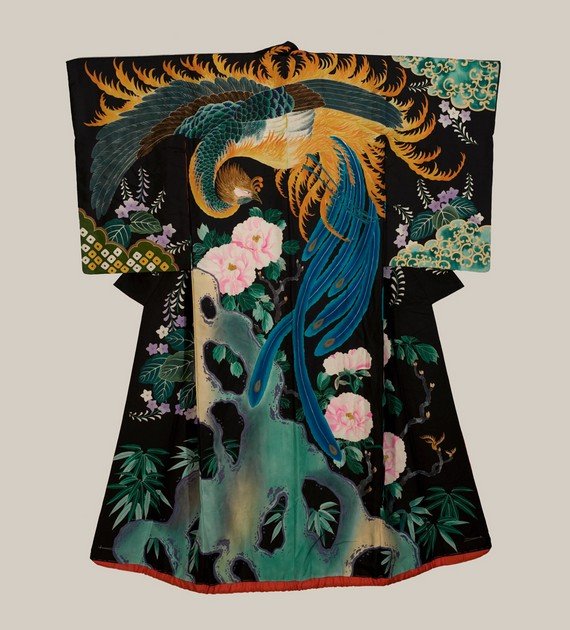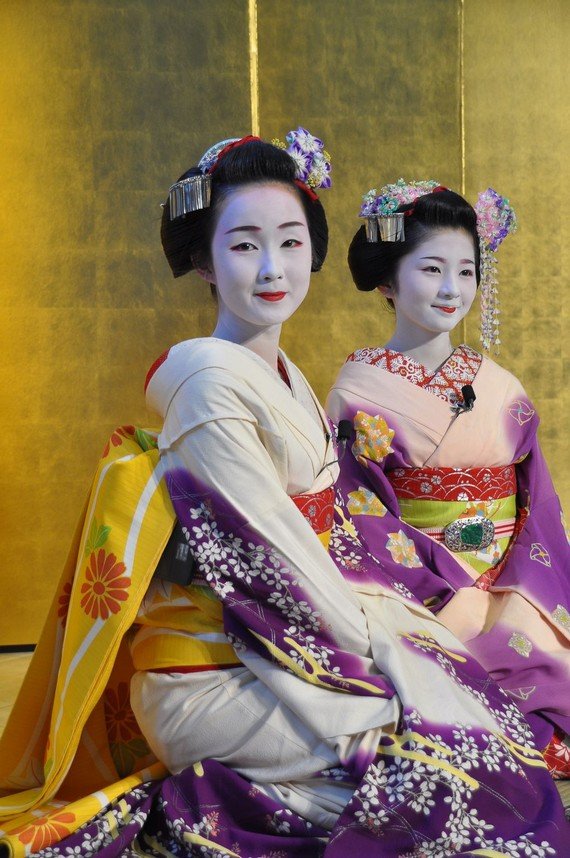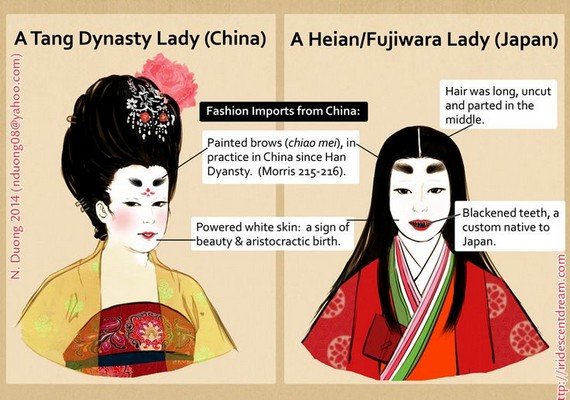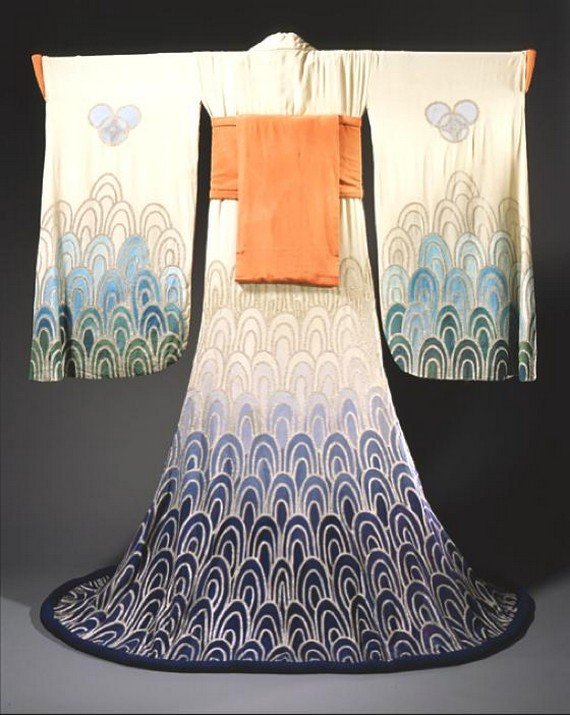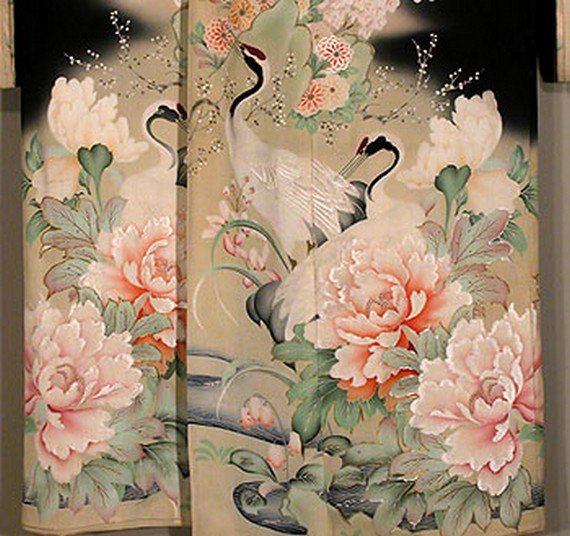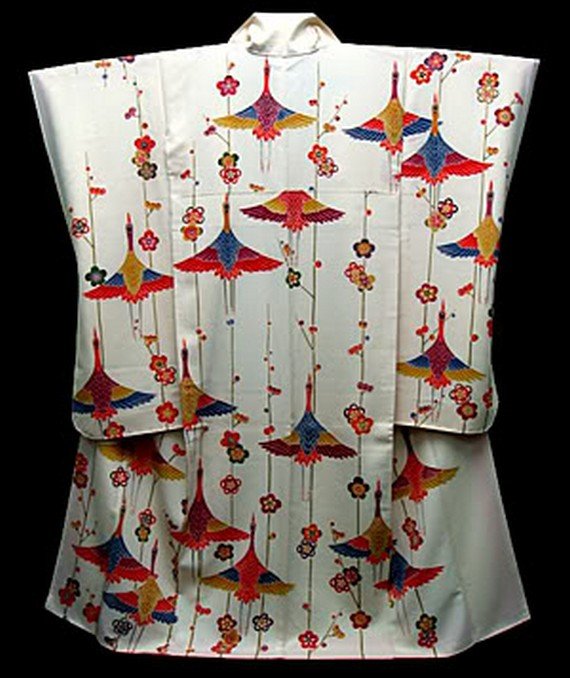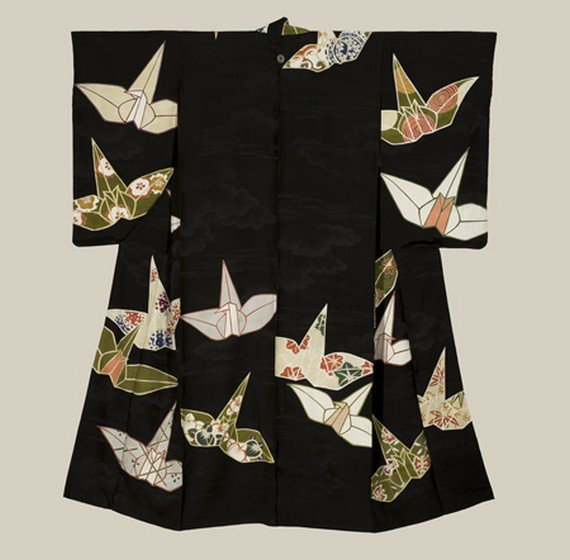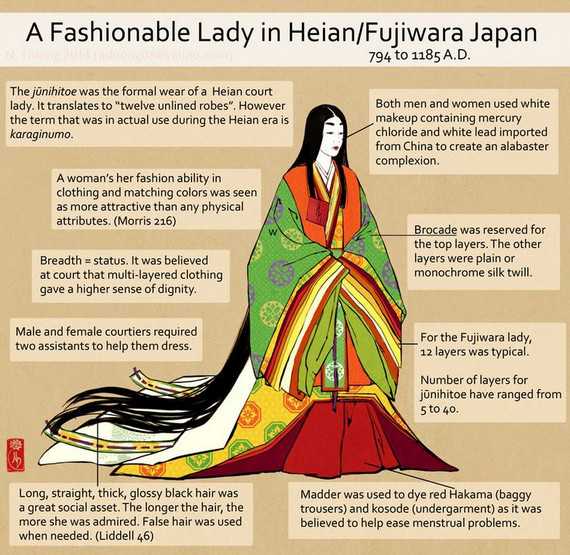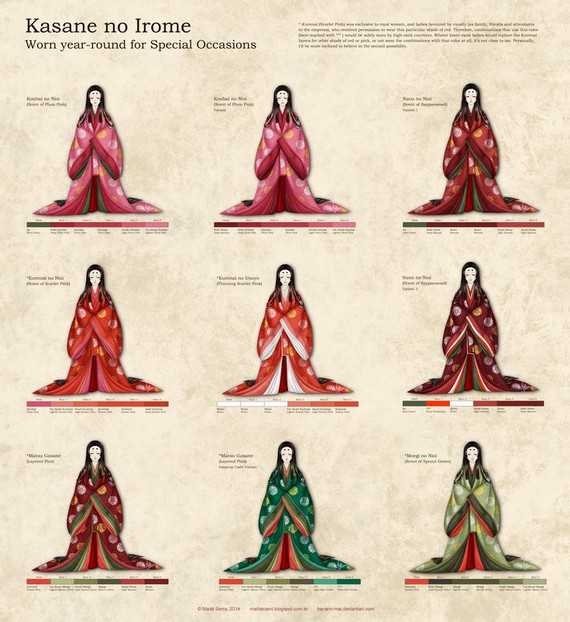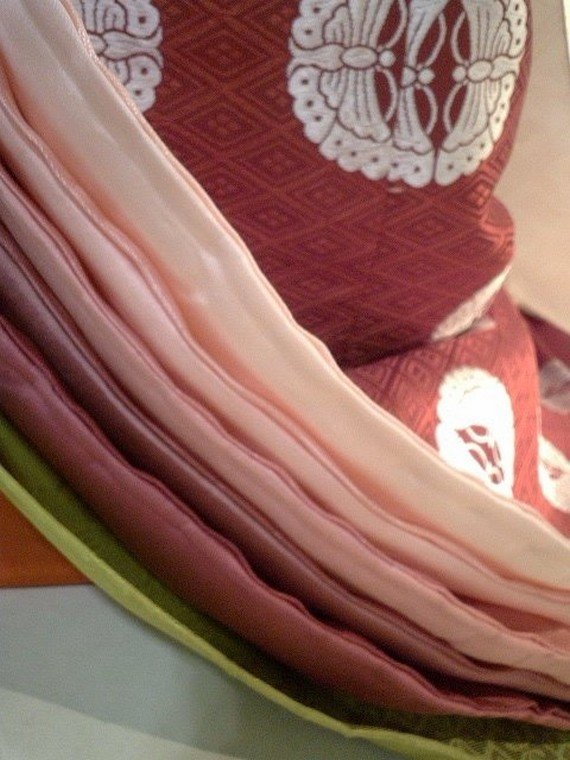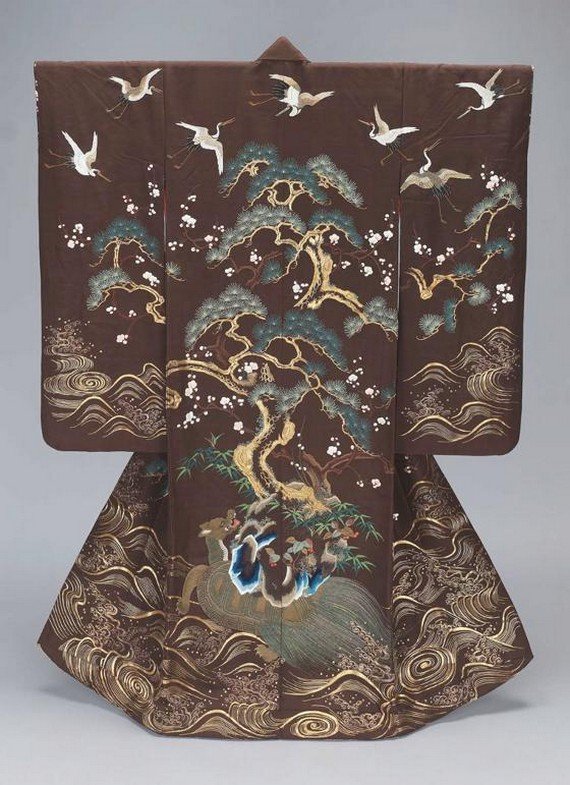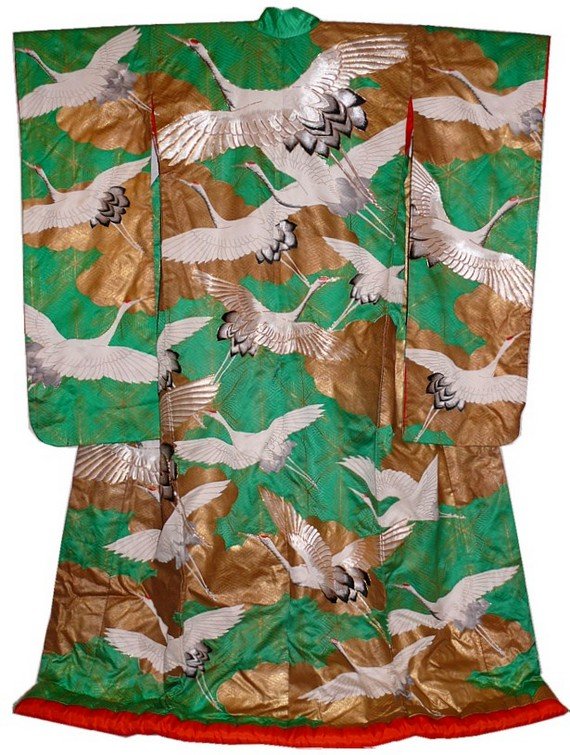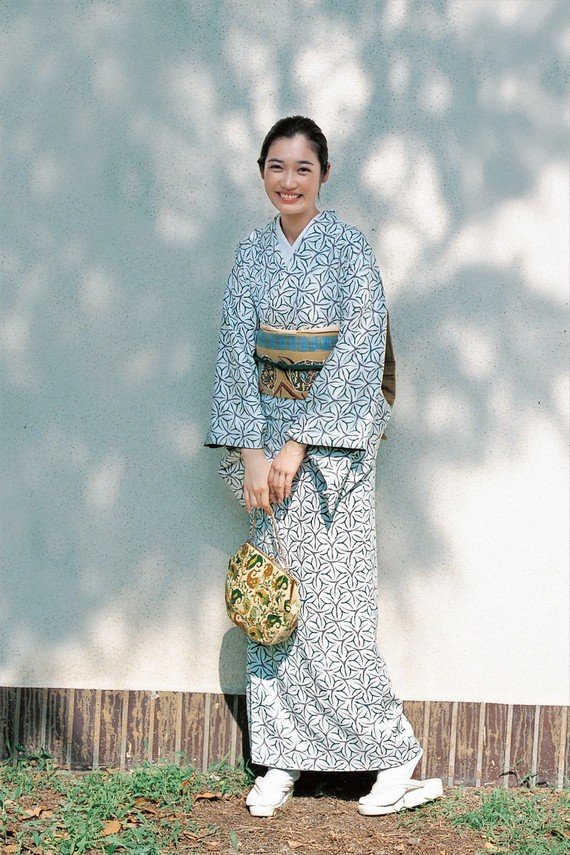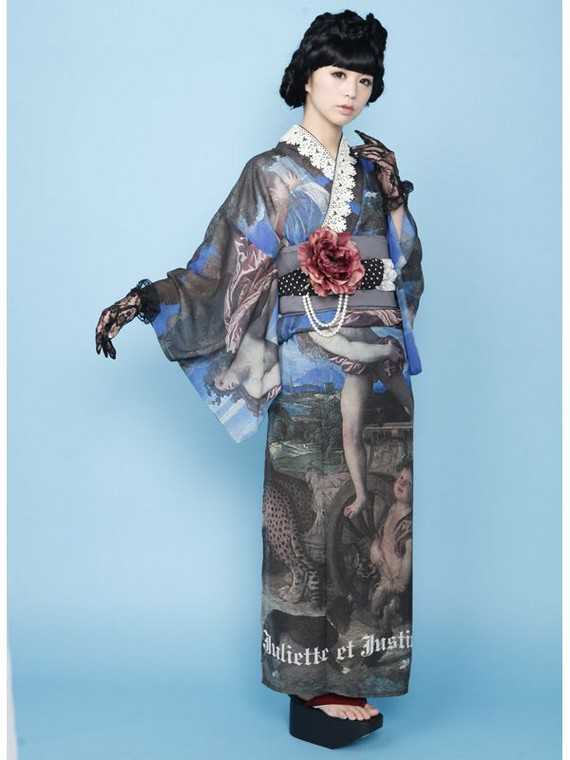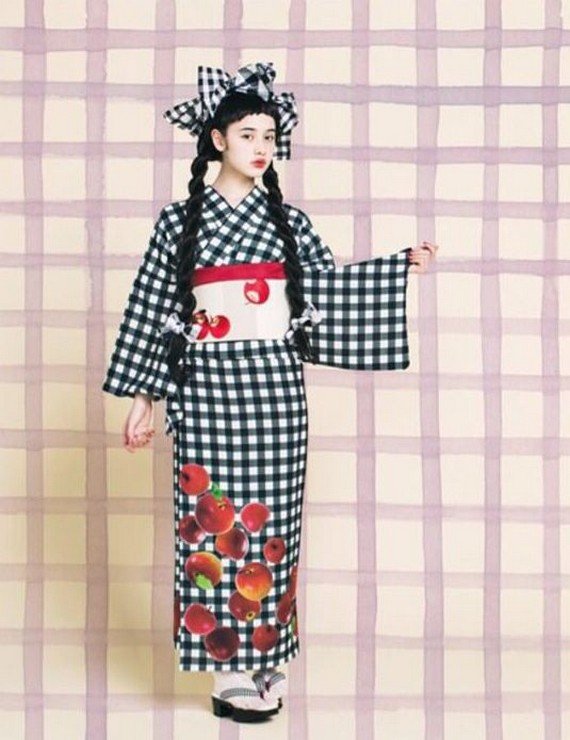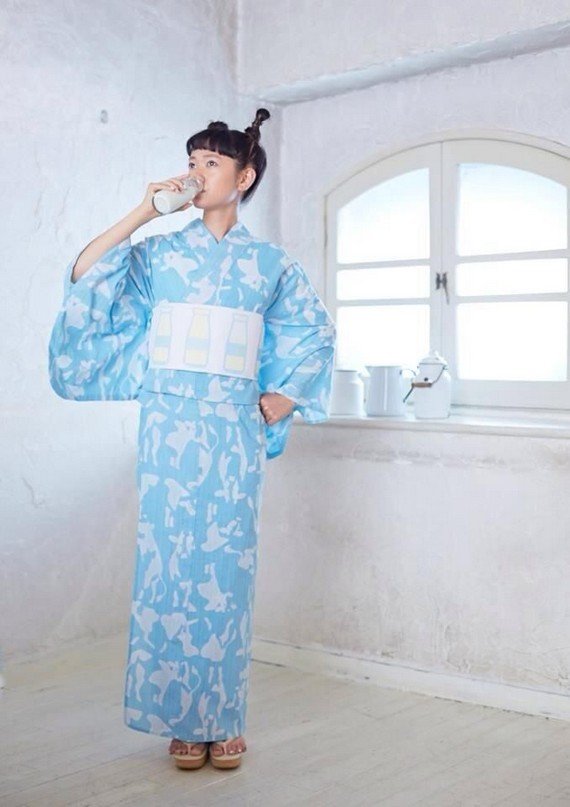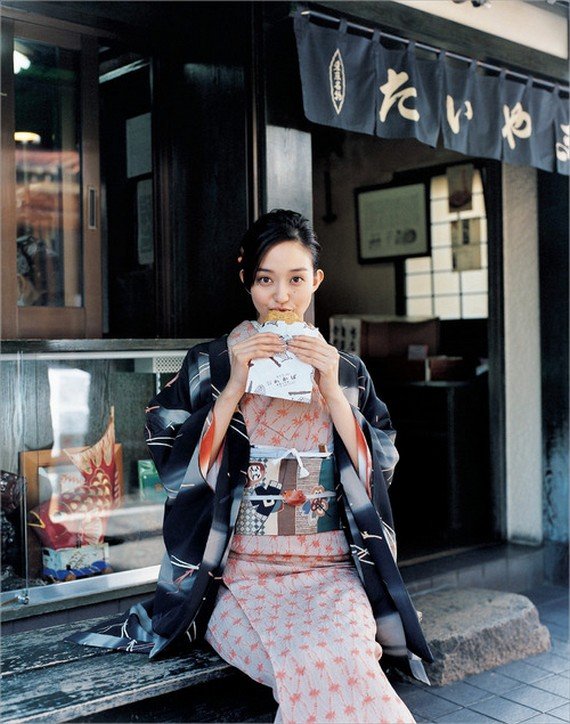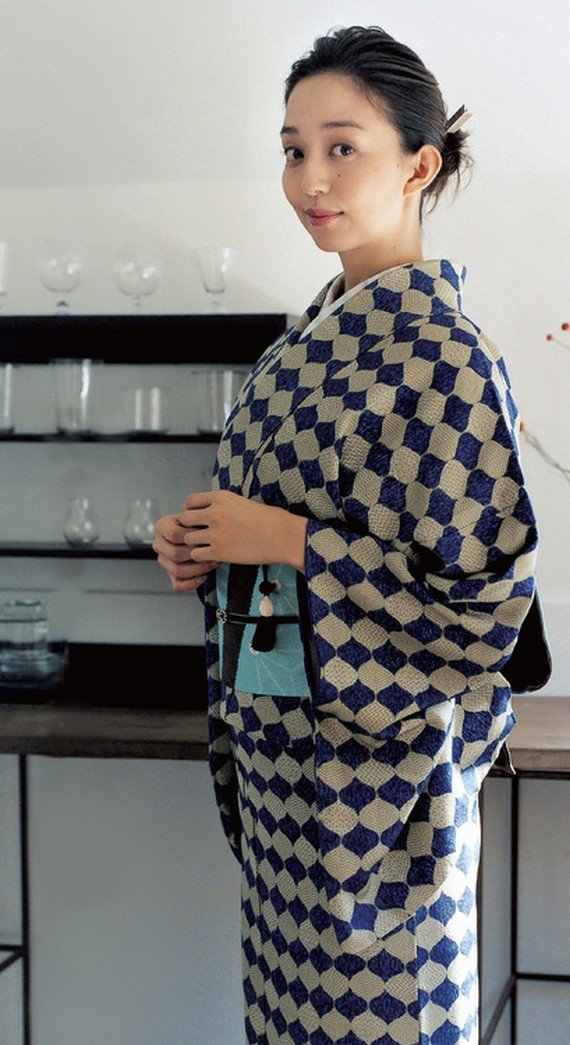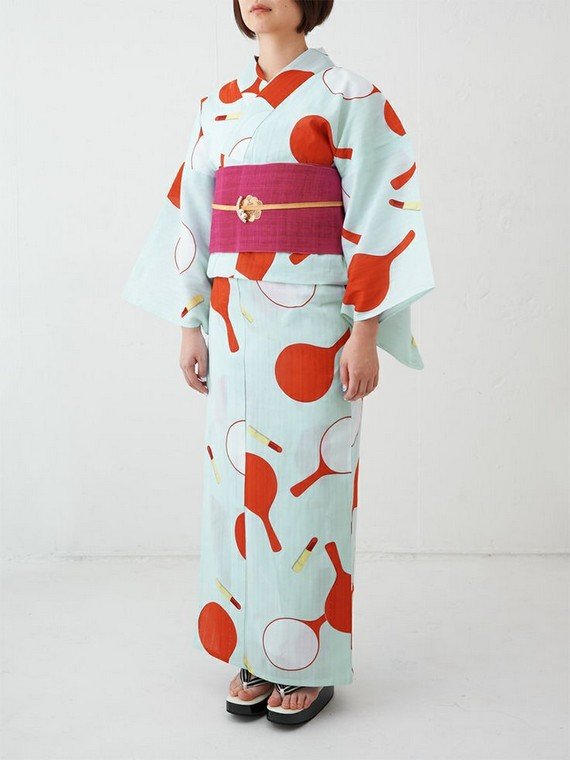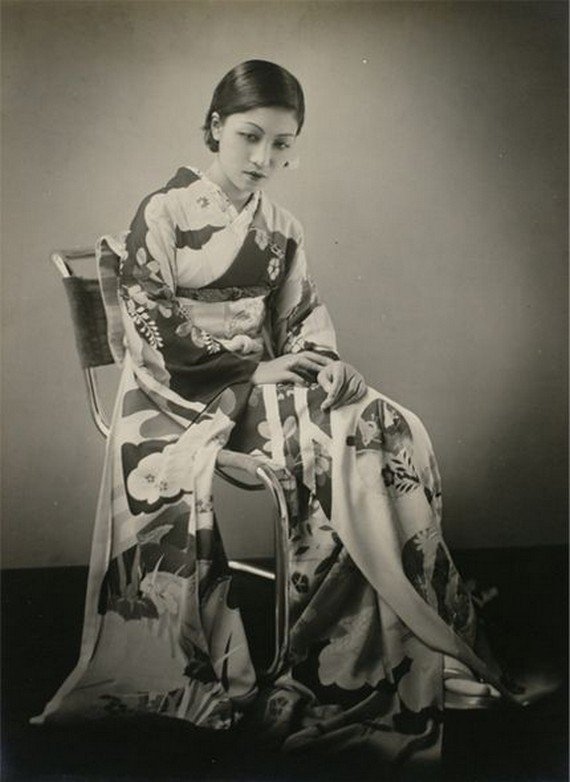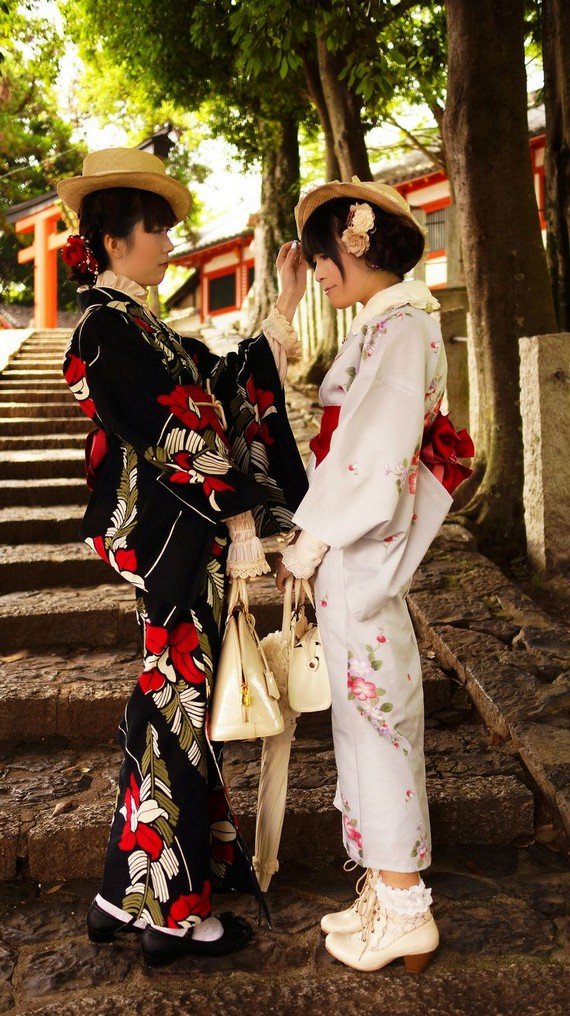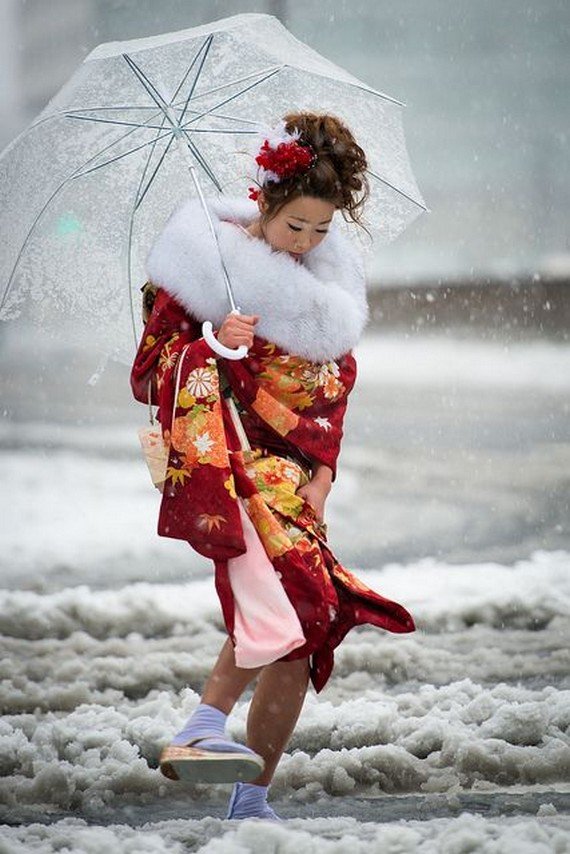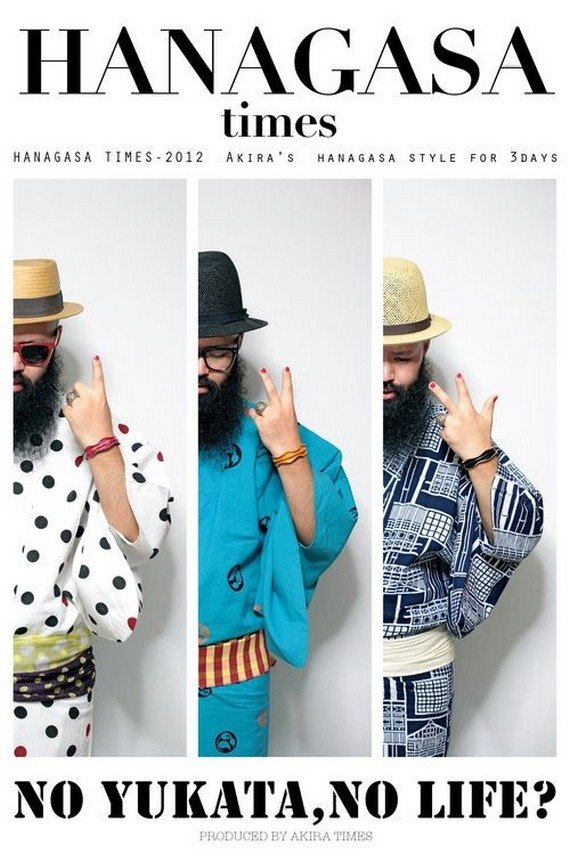Kimono History – Kimono Timeline – How to wear a kimono – Blue17
October 19, 2014Kimono, Japanese traditional garment literally translated as “a thing to wear” (ki – wear; mono – thing), is not a single style of dress but a complex system of stylishly coordinated and layered garments and accessories that subtly reflect and reference the wearer’s age, personality, sophistication, social and marital status, as well as awareness of occasion and season.
Kimono is a complex visual codex of presenting oneself within social and natural world. Rooted in tradition that varied only very subtly over the centuries, it can simultaneously represent creative individuality and restrained uniformity, agelessness and temporality, personal style, heritage, and humble oneness with nature.
Kimono Timeline
The earliest kimonos, appearing around Heian period (794-1192), were influenced by Chinese garments and introduced the straight T-shape and the overlapping collar, two mainstays throughout the changing fashion of the kimono. The male and female kimonos were originally very similar, pairing them with hakama, the loose trousers/split skirt, and not gendering the patterns. In the 14th century (Muromachi era), they started to be worn long and tied with obi (belt), which increasingly widened as the silhouette became gradually more stiff and formal. From the Edo period (1603-1867) onwards, the shape of the female kimono took its present form.
Kimono facts
Traditional Japanese Kimonos are lavish, beautiful things made to last. Sewn by hand from a single bolt of fabric (11.5 m long) in embroidered, woven and painted silk, worn with many layers of undergarments and special accessories, kimonos can take hours to put on and cost up to several thousands of pounds. Obi, the decorative and structural backbone of the kimono, can cost around two thousand as well – but both vintage kimonos and obis can be found second-hand for a fraction of the price.
Woven and uniformly block-printed kimonos and obis are considered less formal, whereas hand-painted garments, especially with use of gold and silver thread, are traditionally used for more formal occasions. Stylistically, it is recommended to wear woven kimono with a printed obi and vice versa, not layering the same method in one outfit. Hand-painted craftsmanship includes yuzen (the method of painting precise motifs directly on the silk) or shibori (a minute tie-dye technique), as well as poetically seasonal embroidery. Some of the more contemporary designs use patchwork and recycled vintage silks, and materials can also be wool, silk crepe, sateen, cotton, linen, and synthetics.
Dressing for occasion
If getting dressed in a kimono is complicated, then coordinating the colours, materials and styles to suit the occasion is akin to a war strategy, which it must have been among the stylish court ladies or geishas paying a visit, strolling casually in the park or attending specific ceremonies and formal events.
The materials are layered from the thinnest, gauziest hadajuban and susoyoke (the more modest equivalent to Western camisoles and slips) to crisp nagajuban, or the full-length under-kimono, via strategic placement of collar stiffeners, snap-fasteners and paddings intended to bind and smooth the outward appearance (in contrast with the Western silhouette, but no less corrective), to the weightier kimono or yukata, and ending with lavish thick obi, obi-age (the top-of-obi lining, which protrudes like a gentleman’s handkerchief in a breast pocket), obijime (decorative cord), obidome (a single bead in the middle of the cord), netsuke (dangly charm that reflects the wearer’s personality) stylish hair accessories, footwear, possibly even a haori (coat).
Kimonos and the Obi
Thick, textured showpiece silks are reserved for the obi, which is why it makes sense to invest in several obis to be worn with a single stylish kimono, changing its appearance and seasonality. Obis (be it cheerful yukata obi with its bow that looks like “the neck of a clam”, or the chic Nagoya obi with taiko, the stiff back bow), add accent to the plainer kimonos and conversational charm to the more glamorous ones. The subtle complexity of contemporary kimonos reflects only a fraction of its past glory, when the wearer had to strategically and tastefully put together over twelve layers of robes whose highly meaningful textures, patterns and symbols could probably be read like a period novel by a knowing couturier.
Kimono History Part 2
The pattern and colour of kimono determines its formality, and its themes reflect seasonality and the wearer’s sophistication. There are more than 1300 traditionally used colours (including the ones known as “unnamed”), of which 465 are widely used in kimono patterns. The names of the shades may seem poetic but are in fact quite literal, coming from the nature and the everyday life. ‘Tea leaf mouse’ varies subtly from ‘turtledove’, ‘indigo-kelp-brown’ is symbolically if not always visibly worlds away from the ‘thousand-years-brown’, ‘young seedlings’ are quite a different green from ‘young grass’, or ‘young green onion’, or ‘summer insect green’, or indeed the ‘reverse side of willow leaves’.
Meaning of colours
Each colour represents awareness of the certain aspect of nature depending on its chromatic properties, but also evoking the plant or mineral the dye is taken from, so for example if ‘ai’ (indigo) was used medicinally against insect bites, it was widely considered that an indigo-coloured garment will protect against them, too. To complicate matters further, individual colours in combination with another became compound-terms (a little like the Victorian language of flowers lent complex meaning to bouquets), determining certain combinations wearable only in certain seasons, during particular holidays or at different ages.
Motifs
The motifs on garments are carefully chosen to deepen the story carried by colours and textures: for example, spring is reflected by Japanese iris, cherry blossom, flowing clouds, Hina Matsuri dolls and old palace scenes; summer is symbolised with summer creatures and plants but also wind chimes, waves and streams, which creates the illusion of cooling movement; autumn is symbolised by moon-viewing, wild geese, pampas grasses and chrysanthemums; winter is snow, plum blossom, pine and bamboo.
Any of these could be subtly quoted through poetry (calligraphic beginnings of poems were probably as familiar as contemporary t-shirts with rock-star quotes), and family emblems were as revered as the modern day Gucci or Chanel logos. At certain points, the artisan-makers felt inclined to add some good old-fashioned epic glamour, depicting entire scenes from the Tale of Genji or heroic battles on the length of silk, to be worn and admired like a scroll (or like an intricate comic book). At other times, they evoked the symbolism of the five elements – fire, water, air, earth and metal – their inherent properties and celestial patronage transferring itself to the wearer. It is easy to see how this spirit translates itself onto present-day manga characters, superheroes, elementals and supernatural imagery in contemporary Japanese clothes and accessories.
Hierarchical order
The sense of hierarchical order, so strong in Japanese, is visible in symbolic layering that places humans within the natural world, but also within the symbolic world inhabited with deities, ancestral ghosts and revered annual celebrations. The dead were given the space to coexist, reflected in both festivals of the dead and in the way they were dressed. The kimono is worn left side over right (remember the useful “left over rice” mnemonic) by the living, regardless of their gender, and right over left by the deceased.
Quite simply, kimonos are sensory journeys for the wearer and their admirers. The list of its various symbolisms is long and interpretations vary from era to era, from one fashion fad to another, but deeply informed passion for nuance, theatricality, tactile evocativeness and bold storytelling remain crucial to both interpreting and wearing kimonos.
Contemporary kimono
So how does one wear kimono in contemporary fashion? Does anybody, other than geishas, sumo wrestlers and Japanese-themed bar staff integrate kimono wear into their everyday life?
It would appear that they do. Quite apart from the professional kimono wearers and the ongoing interest of the fashion designers that keep dipping into the lines and fabrics of kimonos for inspiration (Yamamoto, …), there has been a renewed interest among young women in Japan who scour second hand stores and their mothers’ and grandmothers’ wardrobes for vintage kimonos and obis, which they bring up to date with fresh new fabrics, accessories and colour accents. And among the Western women, kimono has never stopped being a lovely addition to their wardrobe, not just as loungewear but as a liberating, feminine garment for special occasions.
Choosing a kimono
Whether you’re choosing a vintage kimono or making your own interpretation of the garment, there are some things to bear in mind. Kimono as everyday wear, with the full set of accessories and undergarments, will probably look best if you’re a native Japanese or Asian. While it’s not exactly disrespectful to wear kimono, obi and zori every day if you’re a westerner, the overall effect is similar to wearing rubber fetishwear to Tescos: it looks more cosplay than cute. Unless you’re a geisha or a dedicated cosplayer, kimono is a subtle garment that needn’t seek attention quite so loudly. It’s beauty is in its quality, coordination of textures and colours, and stylishness of its wearer. Of course, there’s nothing better than a kimono for when you do wish to dress up: it can be brilliantly personalised and glamourous. But if you wish to wear it every day, consider the following:
1.Silhouette
Putting on a kimono and obi is a time-renowned ritual which, to a novice, will take time and practice. Seek good instructional videos or look up Nanao, Japanese kimono-focused magazine, for advice how to put your nagajuban (underkimono), kimono, koshi-himo, mura-himo, date-jime, obi, obi-ita, obi-makura, obi-age, and obijime on. A good glossary will also come handy!
The traditional kimono silhouette favours the narrow, tubular body, slightly sloped shoulders, high neckline (with somewhat lower neckline on the back if you wish to appear particularly seductive), dramatic taiko (bow) at the back of your obi. It is generally thought that kimonos offer a better look from behind than from the front, because that is where the most of the decorations and the taiko are.
To achieve the tubular body shape, Japanese typically use a slightly binding bra and a set of small towels and pads between the breasts and belly to even out the front, so the obi lies flat and the material doesn’t wrinkle. Some pads can also be added to the shoulders (to slope, not to uplift), and the back. Practically, this approach to binding and padding differs diametrically from the western accentuation of breasts, waist and bottom. When binding, think of kokeshi dolls for inspiration. The flair of the silhouette is achieved by lavish, mobile sleeves, firm taiko and the delicate collar.
2. Materials.
Unless it’s your wedding day or you wish to look like a sweetie wrapper, rich embroidered silks and brocades are best left for special occasions.Then how to wear a kimono for everyday wear favours wools, cottons and linen in discreet patterns and colours. If you’re typically wearing a lot of dark colours, it would be easier to incorporate a dark kimono with a subtle weave into your wardrobe, or to accentuate your outfit with a bright detail. Full-on patterns and painted silks look their best used sparingly, or in a clever combination with bold block colours. A light, summer yukata or jinbei in minimal cool palette of colours is a great way to start wearing a kimono and to blend it gradually with your existing wardrobe.
3.Kimono Accessories
Zori, geta or Nike? Pair your vintage kimono with the right footwear, such as gorgeous patent leather zori, or wear it with rock-chick style with a leather belt and knee-high boots. If you wear hats, don’t spoil the balance, and take particular care that your usual bags don’t appear frumpy and old-fashioned next to your lovely cheerful kimono. Thanks to the growing trend of wearing vintage kimonos, customising and accessorising kimonos has never been easier.There is a world of obi makers and obi accessories to choose from, and you can also make or embroider your own. Hairstyle sounds like an obvious thing to keep in mind when dressing up in kimono: remember not to fully cover your neck, thus spoiling the silhouette.
However you choose to wear a kimono, be it traditional-with-twist in homage to classical kimono wear, spectacularly lavish in the style of Kabuki dancers for partywear, or to blend and adapt its lines to your existing wardrobe, there’s probably a kimono out there that will match your fantasy. It helps to get acquainted with the history and meaning of kimono, it’s materials, symbols, styles and fashions; but you don’t need to be a kimono historian to enjoy its versatile beauty every day.



